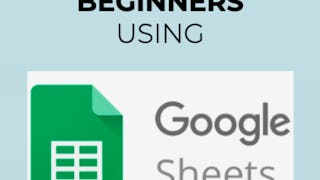Le simple tableur est l'un des outils d'analyse de données les plus puissants qui soient, et il est à la portée de presque tout le monde. Les grandes sociétés comme les petites entreprises utilisent des modèles de feuilles de calcul pour déterminer où se situent actuellement les mesures clés de leur succès et où elles sont susceptibles de se situer à l'avenir. Mais pour tirer le meilleur parti d'une feuille de calcul, il faut savoir l'utiliser. Ce cours est conçu pour vous donner une introduction aux outils et formules de base des tableurs afin que vous puissiez commencer à exploiter la puissance des tableurs pour cartographier les données dont vous disposez actuellement et pour prédire les données dont vous disposerez à l'avenir. Grâce à des démonstrations courtes et faciles à suivre, vous apprendrez à utiliser Excel ou Sheets afin de pouvoir commencer à construire des modèles et des arbres de décision dans les prochains cours de cette Specializations.

Profitez d'une croissance illimitée avec un an de Coursera Plus pour 199 $ (régulièrement 399 $). Économisez maintenant.

Introduction aux feuilles de calcul et aux modèles
Ce cours fait partie de plusieurs programmes.

Instructeur : Don Huesman
130 809 déjà inscrits
Inclus avec
(3,879 avis)
Compétences que vous acquerrez
- Catégorie : Optimisation des processus
- Catégorie : Recherche opérationnelle
- Catégorie : Simulation et logiciels de simulation
- Catégorie : Prévisions
- Catégorie : Formules Excel
- Catégorie : Analyse
- Catégorie : Modélisation financière
- Catégorie : Google Sheets
- Catégorie : Analyse prédictive
- Catégorie : Analyse de régression
- Catégorie : Logiciel de Feuille de Calcul
- Catégorie : Arbre de décision
- Catégorie : Microsoft Excel
- Catégorie : Méthodes statistiques
- Catégorie : Analyse des risques
- Catégorie : Distribution de probabilité
- Catégorie : Modélisation d'entreprise
- Catégorie : Logiciel d'analyse des données
Détails à connaître

Ajouter à votre profil LinkedIn
8 devoirs
Découvrez comment les employés des entreprises prestigieuses maîtrisent des compétences recherchées

Élaborez votre expertise du sujet
- Apprenez de nouveaux concepts auprès d'experts du secteur
- Acquérez une compréhension de base d'un sujet ou d'un outil
- Développez des compétences professionnelles avec des projets pratiques
- Obtenez un certificat professionnel partageable

Il y a 4 modules dans ce cours
Ce module a été conçu pour vous présenter l'histoire des feuilles de calcul, leurs capacités de base et la manière dont elles peuvent être utilisées pour créer des modèles. Vous apprendrez les différents types de données utilisés dans les feuilles de calcul, les notations des opérations mathématiques, les formules et fonctions intégrées courantes, les expressions conditionnelles, les références relatives et absolues, ainsi que la manière d'identifier et de corriger les références circulaires. À la fin de ce module, vous comprendrez le contexte des feuilles de calcul, serez capable de naviguer dans une feuille de calcul, d'utiliser les formules et fonctions intégrées dans les feuilles de calcul, de créer vos propres formules simples et d'identifier et de corriger les erreurs courantes afin de mettre les feuilles de calcul à votre service.
Inclus
6 vidéos2 lectures2 devoirs
Dans ce module, vous passerez de la feuille de calcul au modèle, afin de commencer à créer vos propres modèles qui reflètent les événements du monde réel. Vous apprendrez à organiser et à présenter les éléments d'un modèle, ainsi que les types de fonctions objectives et leur utilisation. Vous apprendrez également l'analyse de simulation et les scénarios, l'analyse de sensibilité et d'autres modèles classiques. À la fin de ce module, vous serez en mesure de concevoir une feuille de calcul reflétant les hypothèses, les variables de décision et les résultats, de créer un modèle de flux de trésorerie de base, d'évaluer une opportunité de petite entreprise, de mener une analyse de simulation, d'identifier les variables clés à l'aide de l'analyse de sensibilité, ainsi que des modèles de programmation linéaire et des modèles déterministes.
Inclus
6 vidéos2 lectures2 devoirs
Ce module a été conçu pour vous présenter la manière dont vous pouvez utiliser les feuilles de calcul pour aborder l'incertitude et les probabilités. Vous découvrirez les variables aléatoires, les distributions de probabilités, les fonctions puissance, exponentielle et logarithme dans les formules des modèles, les modèles de calcul des arbres de probabilité et des arbres de décision, la manière d'utiliser les outils de régression pour faire des prédictions, ainsi que la régression multiple. À la fin de ce module, vous serez en mesure de mesurer les corrélations entre les variables à l'aide des fonctions statistiques du tableur, de comprendre les résultats des fonctions qui calculent les corrélations, d'utiliser les outils de régression pour faire des prédictions et d'améliorer les prévisions à l'aide de la régression multiple.
Inclus
6 vidéos3 lectures2 devoirs
Dans ce module, vous apprendrez à utiliser des feuilles de calcul pour mettre en œuvre des simulations Monte Carlo ainsi que des programmes linéaires pour l'optimisation. Vous examinerez l'objectif des simulations de Monte Carlo, la manière de mettre en œuvre des simulations de Monte Carlo dans des feuilles de calcul, les types de problèmes que vous pouvez traiter avec des programmes linéaires et la manière de mettre en œuvre ces programmes linéaires dans des feuilles de calcul. À la fin de ce module, vous serez en mesure de modéliser l'incertitude et le risque dans des feuilles de calcul et d'utiliser le solveur d'Excel pour optimiser les ressources afin d'atteindre un résultat souhaité. Vous serez également en mesure d'identifier les similitudes et les différences entre Excel et Sheets, et serez préparé pour le cours suivant de la Specialization Business and Financial Modeling.
Inclus
4 vidéos3 lectures2 devoirs
Obtenez un certificat professionnel
Ajoutez ce titre à votre profil LinkedIn, à votre curriculum vitae ou à votre CV. Partagez-le sur les médias sociaux et dans votre évaluation des performances.
Instructeur

Offert par
En savoir plus sur L'essentiel pour les entreprises
 Statut : Essai gratuit
Statut : Essai gratuit Statut : Essai gratuit
Statut : Essai gratuitRice University
Pour quelles raisons les étudiants sur Coursera nous choisissent-ils pour leur carrière ?




Avis des étudiants
3 879 avis
- 5 stars
50,70 %
- 4 stars
26,70 %
- 3 stars
13,56 %
- 2 stars
5,46 %
- 1 star
3,55 %
Affichage de 3 sur 3879
Révisé le 21 juin 2017
This course has made me understand cost accounting, has provided a fresh perspective on how to solve some of the challenges i had with management accounting and as a bonus, made me love maths again :)
Révisé le 15 août 2020
The course was exceptional. I learnt a lot about excel and google sheet from this course. The instructor has been very smooth and clear in teaching his concepts. I am deeply grateful.
Révisé le 29 juil. 2021
This course is a must for all the learners who want to go ahead and achieve big because this course not just teaches you about financial scenarios etc. but the knowledge can be used in real life

Ouvrez de nouvelles portes avec Coursera Plus
Accès illimité à 10,000+ cours de niveau international, projets pratiques et programmes de certification prêts à l'emploi - tous inclus dans votre abonnement.
Faites progresser votre carrière avec un diplôme en ligne
Obtenez un diplôme auprès d’universités de renommée mondiale - 100 % en ligne
Rejoignez plus de 3 400 entreprises mondiales qui ont choisi Coursera pour les affaires
Améliorez les compétences de vos employés pour exceller dans l’économie numérique
Foire Aux Questions
Pour accéder aux supports de cours, aux devoirs et pour obtenir un certificat, vous devez acheter l'expérience de certificat lorsque vous vous inscrivez à un cours. Vous pouvez essayer un essai gratuit ou demander une aide financière. Le cours peut proposer l'option "Cours complet, pas de certificat". Cette option vous permet de consulter tous les supports de cours, de soumettre les évaluations requises et d'obtenir une note finale. Cela signifie également que vous ne pourrez pas acheter un certificat d'expérience.
Lorsque vous vous inscrivez au cours, vous avez accès à tous les cours de la spécialisation et vous obtenez un certificat lorsque vous terminez le travail. Votre certificat électronique sera ajouté à votre page Réalisations - de là, vous pouvez imprimer votre certificat ou l'ajouter à votre profil LinkedIn.
Oui, pour certains programmes de formation, vous pouvez demander une aide financière ou une bourse si vous n'avez pas les moyens de payer les frais d'inscription. Si une aide financière ou une bourse est disponible pour votre programme de formation, vous trouverez un lien de demande sur la page de description.
Plus de questions
Aide financière disponible,



